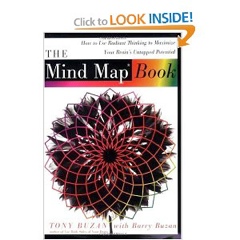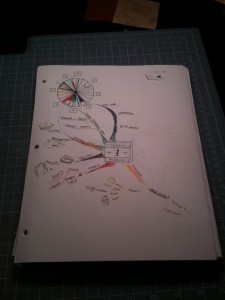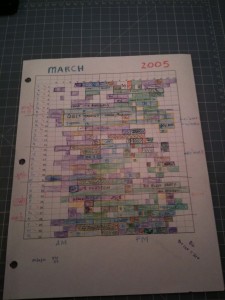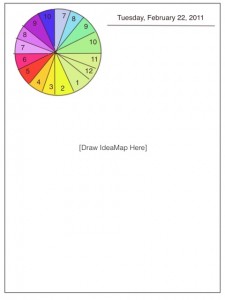Do I Use My Tools or Do They Use Me?-Part 1
Uncategorized Tagged GTD, ideamapping, iThoughts, Jamie Nast, Merlin Mann, MindManager, mindmapping, Vanda North February 23rd, 2011DO I USE MY TOOLS OR DO THEY USE ME?
It’s been such a long time since I contributed anything to this blog. It was not intentional, but I can rationalize it as having nothing significant to contribute to cyber space.
Well, I am beginning to work on a theory that will hopefully result in something that is significant for me (and maybe you, as well) concerning the ideal life management tool.
THE CHALLENGE
How do I express my interests and responsibilities in a successful visual way so that I feel confident that I am moving forward every day to living a full and vibrant life?
As heady as that sounds, let me explain in more concrete language. It’s about time management and task management.
From the beginning of my working career, I’ve dabbled with various time management tools. Here is a list:
43-Folders (paper)
DayTimer (paper)
Timeslips (digital time and billing)
Mindmapping (paper)
UPO (paper)
IdeaMapping (paper)
MindManager (digital)
iThoughtsHD (digital)
Omnifocus
OmniPlan
GTD (paper and digital)
It might not be complete, but you get the point, I hope.
The very first tool I used was what is now called 43-folders by Merlin Mann (www.43folders.com) I began using it in 1982 at my first job as a tax accountant for a bank in Rochester, New York. I still use this system every day at home and in the office. It is a simple, yet very effective tool for capturing pieces of paper. It’s weakness, for me, however, is that it is linear and doesn’t give a “big-picture view of what’s coming.
When I changed jobs to be a paralegal for a County Attorney’s office in the Finger Lakes area of New York, I encountered the DayTimer system (www.daytimer.com). At that time, there was only a paper-based version. This was the first structured system for time management that I used that was easily portable. It gave me some overview capability because I could flip the pages and see what was coming, and because I only wrote in pencil, it was fairly flexible in adjusting tasks from day-to-day and month-to-month. I used this system for many years.
When I opened my own law practice, I continued to use the DayTimer and 43-Folders systems, but added Timeslips (www.Timeslips.com) for my time and billing software. I had to manually enter my billable hours so that I could produce an invoice for my clients. This was not very efficient as it required double-entry, but it handled that aspect of my time management.
Then came the lightning bolt that changed everything and sent me off in new directions. I read Tony Buzan’s book “The Mind Map Book”.
Suddenly, I saw the possibility for visual expression of thoughts. This was so far away from linear time management, that it was a complete paradigm shift. I immediately signed up for a 3-day course in Florida given by Vanda North(www.mindchi.com) and Jamie Nast (www.ideamappingsuccess.com) to learn how to MindMap. At first, I did not think of this tool as something I could use for time management. I saw immediate uses, however, in my law practice for explaining and visualizing complex concepts, and used it extensively with my clients.
Then I learned about Vanda North’s adaptation called “UPO” (Universal Personal Organizer). Vanda wrote about this tool she uses in 1997 as a life management tool. Here was the answer to more of my questions about how to see the bigger picture of what was coming and what I wanted to accomplish with my time. This tool represents, on one sheet per day, the clock (for appointments), and mapping, in the main space of the page for context-specific thoughts.
It also has sections for a 12-month calendar, that I made with a large spreadsheet.
Along the left column I put the month names and across the top were the days of the week. I then made cells for each day within the month like a big 12-month calendar.To make it a reasonable size, I printed it over 2 sheets of 8 1/2 x 11 paper and taped it together.
There was also a monthly section for a calendar for that month.
Another spreadsheet did the trick here. I put 1-31 down the left column and the hours of the day 6:00 am to 10:00 pm across the top.
Separate sections aren set aside for other aspects of your life: yourself, family/friends, creativity, and wealth.
Each day, I would create a new daily sheet with map and calendar items.
It was a conscious daily activity to make that day’s sheet. Each month, new blank daily sheets are put in and the old sheets are archived into binders. This system is very powerful and fulfilled almost all my needs. As I continued to use it, I became aware that it’s size (8 1/2 x 11 binder) was cumbersome. I even adapted it for 1/2 size, but, although this helped in portability, it didn’t solve the other issue of flexibility. I used the calendar portion with color-coding to distinguish various roles I play; from personal, work, family…As soon as I went away from pencil, to something more permanent, I lost flexibility, and eventually, this and the size issue spelled the end of it’s usefulness for me, although I miss some elements of this tool today.
MindMapping and now, IdeaMapping, by Jamie Nast, have changed the way I look at tools, and what I demand of them. Thanks to MindJet (www.mindjet.com), and the Mindmanager program, making maps is easy and very flexible. Its power is digital, and deep. Things can be attached, linked and changed at near light speed. I use MindManager nearly everyday in my work as an assistant to my husband’s financial management practice. (I retired from practicing law, not because of age, but to spend more time pursuing more creative and less stressful pastimes).
Thanks to several classes I’ve taken with Jamie Nast on IdeaMapping, I’ve come to learn about GTD, as created by David Allen in his book “Getting Things Done”. (www.davidco.com).This is a system of life management as well as time management. It addresses not only the daily tasks, called “Next Actions”, but also works up in scope to Projects, Goals and Objectives, Principals, and Vision, each one viewed as though looking at your life from differing altitudes. After reading his book, I did the work necessary to set up a paper-based system.
I used sticky notes, a generic daily planner (a 3-ring small binder). I adapted the various sections to hold the different altitude sections. I used the daily sheets to hold sticky notes for next actions for each day. I would move them around from day to day as needed, and put them in months to come for actions that would not be needed until later. It was simple, yet effective, but somewhat cumbersome to carry, like the smaller UPO system.
I longed for a digital version that I could put on my iPod (now iPhone and iPad). Thanks to my teenaged son, I learned of Omnifocus by Omni Group (www.omnigroup.com) and Things by Cultured Code (www.culturedcode.com). Both Apps were designed to work with the GTD principles. Both work well to manage the linear nature of the GTD system. Initially, I used Omnifocus, but it became quite slow as my database became larger. They have since solved that issue and it is the App I use now. I used Things in between because it was a more streamlined App, but I missed some of the functionality of Omnifocus.
As I said, these Apps do an excellent job in portability, flexibility, and comprehensive task management. The IPad version of Omnifocus has a Weekly Review feature that makes the process of reviewing projects a breeze. There is a new -App for the iPad called IThoughts HD (www.ipadmindmap.com) (and iThoughts, for the iPhone) , that is much like Mindmanager (there is no iPad version of Mindmanager yet). I’ve been using this for expressing thoughts, in map form. In conjunction with other tools I continue to use (43-folders, MindManager, and hand-drawn IdeaMaps) I have almost everything I could want, but not quite everything.
Thanks for so patiently wading through all this background. If you’re still reading, I appreciate your perseverance. In the next part, I’ll take these tools forward and tell you about my theory on how I hope to complete the big picture I’ve been searching for.





![[Ask]](http://legacy.ideamappingsuccess.com/IdeaMappingBlogs/wp-content/plugins/bookmarkify/ask.png)
![[blinklist]](http://legacy.ideamappingsuccess.com/IdeaMappingBlogs/wp-content/plugins/bookmarkify/blinklist.png)
![[co.mments]](http://legacy.ideamappingsuccess.com/IdeaMappingBlogs/wp-content/plugins/bookmarkify/comments.png)
![[del.icio.us]](http://legacy.ideamappingsuccess.com/IdeaMappingBlogs/wp-content/plugins/bookmarkify/delicious.png)
![[Digg]](http://legacy.ideamappingsuccess.com/IdeaMappingBlogs/wp-content/plugins/bookmarkify/digg.png)
![[Facebook]](http://legacy.ideamappingsuccess.com/IdeaMappingBlogs/wp-content/plugins/bookmarkify/facebook.png)
![[Google]](http://legacy.ideamappingsuccess.com/IdeaMappingBlogs/wp-content/plugins/bookmarkify/google.png)
![[kirtsy]](http://legacy.ideamappingsuccess.com/IdeaMappingBlogs/wp-content/plugins/bookmarkify/kirtsy.png)
![[Ma.gnolia]](http://legacy.ideamappingsuccess.com/IdeaMappingBlogs/wp-content/plugins/bookmarkify/magnolia.png)
![[Netvouz]](http://legacy.ideamappingsuccess.com/IdeaMappingBlogs/wp-content/plugins/bookmarkify/netvouz.png)
![[oneview]](http://legacy.ideamappingsuccess.com/IdeaMappingBlogs/wp-content/plugins/bookmarkify/oneview.png)
![[Propeller]](http://legacy.ideamappingsuccess.com/IdeaMappingBlogs/wp-content/plugins/bookmarkify/propeller.png)
![[Reddit]](http://legacy.ideamappingsuccess.com/IdeaMappingBlogs/wp-content/plugins/bookmarkify/reddit.png)
![[Segnalo]](http://legacy.ideamappingsuccess.com/IdeaMappingBlogs/wp-content/plugins/bookmarkify/segnalo.png)
![[Squidoo]](http://legacy.ideamappingsuccess.com/IdeaMappingBlogs/wp-content/plugins/bookmarkify/squidoo.png)
![[StumbleUpon]](http://legacy.ideamappingsuccess.com/IdeaMappingBlogs/wp-content/plugins/bookmarkify/stumbleupon.png)
![[Technorati]](http://legacy.ideamappingsuccess.com/IdeaMappingBlogs/wp-content/plugins/bookmarkify/technorati.png)
![[Twitter]](http://legacy.ideamappingsuccess.com/IdeaMappingBlogs/wp-content/plugins/bookmarkify/twitter.png)
![[Webride]](http://legacy.ideamappingsuccess.com/IdeaMappingBlogs/wp-content/plugins/bookmarkify/webride.png)
![[Email]](http://legacy.ideamappingsuccess.com/IdeaMappingBlogs/wp-content/plugins/bookmarkify/email.png)